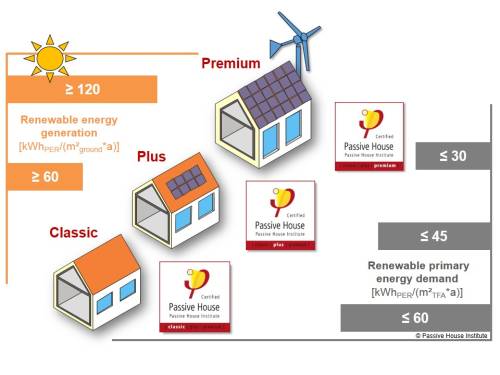This is an old revision of the document!
Table of Contents
The Passive House Classes: Classic, Plus and Premium
Renewable energy is the ideal complement to the efficiency of the Passive House Standard. In order to provide reliable guidance for this combination, the Passive House Institute offers three tiers for its building certification: Classic, Plus and Premium. The classes Plus and Premium were first introduced with PHPP version 9 (2015) as addition to the well-established Passive House Classic.
The heating demand of a Passive House may not exceed 15 kWh/(m²a). This fundamental requirement applies across all three Passive House Classes and reflects the “efficiency first” or “fabric first” approach of the Passive House concept. The assessment of the different classes is driven by the total primary energy demand, as well as renewable energy supply (on-site or nearby). The evaluation methodology “Primary Energy Renewable” (PER) (see details below), serves as a basis for the assessment of the Passive House Classes. In the case of the Passive House Classic category, the renewable primary energy demand must not exceed 60 kWh/(m²a). A building built to Passive House Plus is more efficient as it may not consume more than 45 kWh/(m²a) of renewable primary energy. It must also generate at least 60 kWh/(m²a) of energy in relation to the area covered by the building. In the case of Passive House Premium, the energy demand is limited to just 30 kWh/(m²a), with at least 120 kWh/(m²a) of renewable energy being generated.
There are different ways of achieving a higher Passive House class. This article shows examples of how to reach the different Passive House Classes.
The classification is available for newbuild Passive House buildings, as well as for EnerPHit retrofits. In the case of EnerPHit the PER tragets are adjusted slightly to account for the higher heating energy demand limits.
The PER methodology
The sun and wind provide primary renewable electricity. Some of this electricity can be used directly. However, storage capacities are necessary for transferring surplus energy to time periods with lower energy gains. These supply secondary electricity as required, and this is associated with losses. Depending on the type of energy application, the proportion of primary and secondary electricity varies, as do the losses for providing energy. These specific energy losses of an energy application are described as the respective PER factor. The demand for domestic energy is quite constant throughout the year, which is why the share of direct electricity is high and the PER factor is low. In contrast with this, heating is necessary only in winter. In order to provide enough energy in winter, electricity must in part be produced in summer and stored with very high losses for the winter, which results in a high PER factor.
To learn about the PER methodology in detail, please visit the Passipedia landing page "Primary Energy Renewable" (PER).
See also
Current building certification criteria including the categories Classic, Plus and Premium
Browse implemented projects worldwide in the online Passive House Database. Use the advanced search to filter for Passive House or EnerPHit Class Classic/Plus/Premium.
Classic, Plus, Premium: The Passive House classes and how they can be reached (Lecture given at the 19th International Passive House Conference 2015 by Dr. Benjamin Krick)
iPHA fact sheet No. 3: The new Passive House Classes based on the PER system and their implications
Passipedia landing page "Primary Energy Renewable" (PER)
We welcome any questions or comments regarding the Passive House categories, PER factors or building certification criteria. Please send them to info@passivehouse-international.org.

